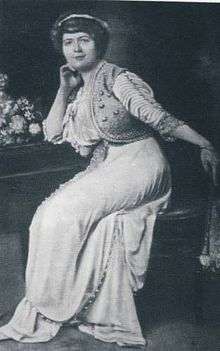Behice Hanım
| Behice Hanım | |
|---|---|
 | |
| Born |
Behiye Maan 10 October 1882 Adapazarı, Ottoman Empire |
| Died |
25 October 1969 (aged 87) Istanbul, Turkey |
| Burial | Yahya Efendi cemetery |
| Spouse | Abdul Hamid II |
| Issue |
Şehzade Ahmed Nureddin Şehzade Mehmed Bedreddin |
| House | Ottoman (by marriage) |
| Father | Albus Maan |
| Mother | Nazli Kucba |
| Religion | Sunni Islam |
Behice Hanım (Ottoman Turkish: بھیجه خانم; born Behiye Maan; 10 October 1882 – 22 October 1969) was the twelfth wife of Sultan Abdul Hamid II of the Ottoman Empire.[1]
Early life
Behice Hanım was born on 10 October 1882 in Beynevid, Adapazarı, Istanbul. Born as Behiye Maan, she was a member of Abkhzian noble family, Maan. Her father was Albus Bey Maan, the grandson of Kats Bey Maan. Her mother was Nazli Hanım Kucba, an Abkhazian.[2][3] She had a sister named Tasvire Hanım.[4][5] She was the first cousin of Sazkar Hanım, ninth wife of Sultan Abdul Hamid II.[6][7]
Marriage
Her father came to know that Abdul Hamid was looking for a bride for his son Şehzade Burhaneddin. He brought his daughter to the court, and presented her to the Sultan. But Abdul Hamid was so taken by the beauty of the young girl that he asked her hand in marriage for himself. Behice refused to this proposal. However, at her father's insistence, she agreed. The marriage took place on 10 May 1900 in the Hünkar Kiosk of the Yıldız Palace. Behice was eighteen, while Abdul Hamid was fifty eight.[8] She was given the title of "Beşinci Ikbal".[1]
A year after the marriage, on 22 June 1901, she gave birth to twins, Şehzade Ahmed Nureddin and Şehzade Mehmed Badreddin.[9] Badreddin died at the age of two on 13 October 1903. In 1909, she was given the title of "Dördüncü Ikbal".[1]
On 27 April 1909, Abdul Hamid was deposed, and sent into exile in Salonica.[10] She didn't followed him, and so remained in Istanbul. She settled with her son in Maslak Palace.[11] After Salonica fell to Greece in 1912, Abdul Hamid returned back to Istanbul, and settled in the Beylerbeyi Palace, where he died in 1918.[12]
Last years and death
In 1924, the imperial family was sent into exile. Behice went to Naples with her son. Her son later moved to Paris, leaving her here, where he died in 1944. In March 1969, she was allowed to enter Turkey, where she died seven months later, on 22 October 1969. She was buried in Yahya Efendi Cemetery, Istanbul.[13][14]
See also
References
- 1 2 3 Uluçay 2011, p. 251.
- ↑ Açba 2007, p. 151.
- ↑ Açba 2004, p. 47-8.
- ↑ Açba 2007, p. 154.
- ↑ Açba 2004, p. 46.
- ↑ Açba 2007, p. 142.
- ↑ Açba 2004, p. 47.
- ↑ Açba 2007, p. 152-3.
- ↑ Tezcan, Hülya (2006). Osmanlı sarayının çocukları: şehzadeler ve hanım sultanların yaşamları, giysileri. Aygaz. p. 147. ISBN 978-9-759-83722-8.
- ↑ Hall, Richard C. (October 9, 2014). War in the Balkans: An Encyclopedic History from the Fall of the Ottoman Empire to the Breakup of Yugoslavia. ABC-CLIO. pp. 1–2. ISBN 978-1-610-69031-7.
- ↑ Açba 2007, p. 153-5.
- ↑ Parry, Milman; Lord, Albert B. (1979). Serbocroation heroic songs, Volume 1. Harvard University Press. p. 371.
- ↑ Açba 2004, p. 52 n. 4.
- ↑ Açba 2007, p. 155-6.
Sources
- Uluçay, M. Çağatay (2011). Padişahların kadınları ve kızları. Ötüken. ISBN 978-9-754-37840-5.
- Açba, Harun (2007). Kadın efendiler: 1839-1924. Profil. ISBN 978-9-759-96109-1.
- Açba, Leyla (2004). Bir Çerkes prensesinin harem hatıraları. L & M. ISBN 978-9-756-49131-7.
- The Concubine, the Princess, and the Teacher: Voices from the Ottoman Harem. University of Texas Press. 2010. ISBN 978-0-292-78335-5.
- Sakaoğlu, Necdet (2008). Bu Mülkün Kadın Sultanları: Vâlide Sultanlar, Hâtunlar, Hasekiler, Kandınefendiler, Sultanefendiler. Oğlak Yayıncılık. ISBN 978-6-051-71079-2.
Further reading
- Osmanoğlu, Ayşe (2000). Babam Sultan Abdülhamid. Mona Kitap Yayinlari. ISBN 978-6-050-81202-2.
_p259_Sultan_Abdul_Hamid_II.jpg)
